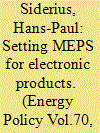|
|
|
Sort Order |
|
|
|
Items / Page
|
|
|
|
|
|
|
| Srl | Item |
| 1 |
ID:
121312


|
|
|
|
|
| Publication |
2013.
|
| Summary/Abstract |
This paper proposes an artificial neural network (ANN) technique as a new approach to evaluate the energy input, losses, output, efficiency, and economic optimization of a geothermal district heating system (GDHS). By using ANN, an energetic analysis is evaluated on the Afyon geothermal district heating system (AGDHS) located in the city of Afyonkarahisar, Turkey. Promising results are obtained about the economic evaluation of that system. This has been used to determine if the existing system is operating at its optimal level, and will provide information about the optimal design and profitable operation of the system. The results of the study show that the ANN model used for the prediction of the energy performance of the AGDHS has good statistical performance values: a correlation coefficient of 0.9983 with minimum RMS and MAPE values. The total cost for the AGDHS is profitable when the PWF is higher than 7.9. However, the PWF of the AGDHS was found to be 1.43 for the given values. As a result, while installing a GDHS, one should take into account the influences of the PWF, ambient temperature and flow rate on the total costs of the system in any location where it is to be established.
|
|
|
|
|
|
|
|
|
|
|
|
|
|
|
|
| 2 |
ID:
126502


|
|
|
|
|
| Publication |
2013.
|
| Summary/Abstract |
In this paper, life cycle analysis has been carried out to evaluate overall performance of given rated stand-alone solar photovoltaic (SAPV) in terms of basic energy matrices, life cycle cost analysis, and earned carbon credit. Further, the experimentally calculated actual on-field life cycle performance results of existing outdoor SAPV system (i.e. almost 20 years old) have been represented with respect to the potential (max.) performance of same SAPV system estimated under same environmental conditions of solar intensity, ambient temperature, PV operating temperature as obtained during actual on-field performance evaluation. This new approach of overall performance evaluation by considering the on-field SAPV system installation as new (i.e. with potential/max. performance) and old (i.e. with actual performance) under same environmental conditions provides an inclusive comparative life cycle assessment of on-field PV system.
|
|
|
|
|
|
|
|
|
|
|
|
|
|
|
|
| 3 |
ID:
150645


|
|
|
|
|
| Summary/Abstract |
The transit authority in Perth, Western Australia, has put several alternative fuel buses, including diesel-electric hybrid and hydrogen fuel cell buses, into revenue service over the years alongside conventional diesel and natural gas buses. Primary data from this fleet is used to construct a Life Cycle Cost (LCC) model, providing an empirical LCC result. The model is then used to forecast possible scenarios using cost estimates for next generation technologies. The methodology follows the Australian/New Zealand Standard for Life Cycle Costing, AS/NZS 4536:1999. The model outputs a dollar value in real terms that represents the LCC of each bus transportation technology. The study finds that Diesel buses deliver the lowest Total Cost of Ownership (TCO). The diesel-electric hybrid bus was found to have a TCO that is about 10% higher than conventional diesel. The premium to implement and operate a hydrogen bus, even if industry targets are attained, is still substantially greater than the TCO of a conventional diesel bus, unless a very large increase in the diesel fuel price occurs. However, the hybrid and hydrogen technologies are still very young in comparison to diesel and economies of scale are yet to be realised.
|
|
|
|
|
|
|
|
|
|
|
|
|
|
|
|
| 4 |
ID:
171423


|
|
|
|
|
| Summary/Abstract |
Geographical maldistribution of coal and water resource has led to huge water consumption, posing great challenges to the development of coal chemical industries in China. In this study, based on the obtained unit product data of water withdrawal, consumption, and wastewater effluent capacity, the wastewater quantitative information about water quality and relevant energy and reagents consumption for several coal chemical industries were analyzed. Then, the life cycle costs of different types of coal chemical wastewater were analyzed when achieving ICIWD (1st category integrated wastewater discharge) and ZLD (zero liquid discharge) standards. According to the results, the life cycle cost of ICIWD was average 0.94 US$/t water less than that of the wastewater meeting ZLD, because the life cycle boundaries focused on coal chemical industries. Given surface water treatment cost and environment damages value, ICIWD's total cost was 1.07 US$/t water higher than ZLD's. Besides, the consumed water of planning advanced coal chemical projects of 2018 took up 2.8% of total industrial water. Such proportion could even reach over 30% in north and northwest regions. It is suggested that ZLD water policies and water resources appraisal should be introduced to improve and strengthen the rational layout of coal chemical projects.
|
|
|
|
|
|
|
|
|
|
|
|
|
|
|
|
| 5 |
ID:
132741


|
|
|
|
|
| Publication |
2014.
|
| Summary/Abstract |
When analysing price, performance and efficiency data for 15 consumer electronic and information and communication technology products, we found that in general price did not relate to the efficiency of the product. Prices of electronic products with comparable performance decreased over time. For products where the data allowed fitting the relationship, we found an exponential decrease in price with an average time constant of ?0.30 [1/year], meaning that every year the product became 26% cheaper on average.
The results imply that the classical approach of setting minimum efficiency performance standards (MEPS) by means of life cycle cost calculations cannot be applied to electronic products. Therefore, an alternative approach based on the improvement of efficiency over time and the variation in efficiency of products on the market, is presented. The concept of a policy action window can provide guidance for the decision on whether setting MEPS for a certain product is appropriate. If the (formal) procedure for setting MEPS takes longer than the policy action window, this means that the efficiency improvement will also be achieved without setting MEPS. We found short, i.e. less than three years, policy action windows for graphic cards, network attached storage products, network switches and televisions.
|
|
|
|
|
|
|
|
|
|
|
|
|
|
|
|
|
|
|
|
|